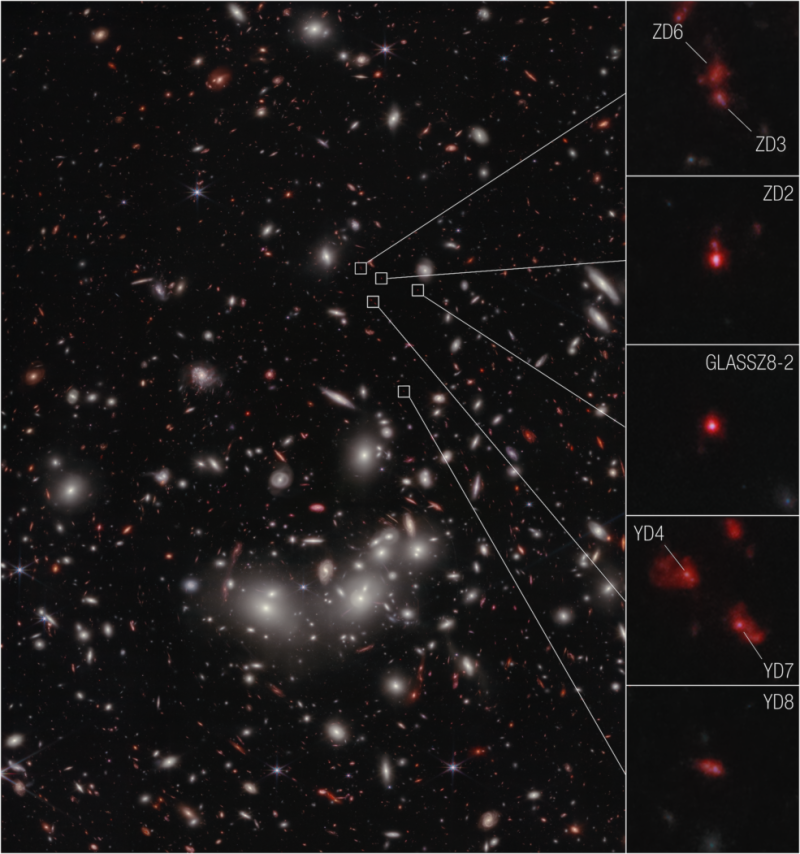Galaxy clusters are the largest concentrations of mass in the known universe, which can dramatically distort the fabric of space-time itself
Every giant was once a baby, though it may never have been seen by human eyes at that stage of development. NASA’s James Webb Space Telescope has begun to shed light on the formative years of the universe’s history that have so far been inaccessible and relate to the formation and assembly of galaxies.
For the first time, a protocluster of seven galaxies has been confirmed at a distance astronomers refer to as redshift 7.9, or just 650 million years, after the Big Bang. Based on the data collected, the astronomers calculated the future growth of the nascent cluster, finding that it will likely grow in size and mass to resemble the Coma cluster, a monster of the modern universe.
The Coma Complex:
“This is a very special, unique site of accelerated galaxy evolution, and Webb has given us the unprecedented ability to measure the velocities of these seven galaxies and confirm with confidence that they are bound together in a protocluster,” said the institute’s Takahiro Morishita IPAC-California. of Technology, the lead author of the study published in the Astrophysical Journal Letters.
Precise measurements recorded by the Webb spectrograph ( NIRSpec ) were key to confirming the collective distance of the galaxies and the high speeds at which they move within a dark matter halo – more than two million miles per hour (about a thousand kilometers ), per second).
The spectral data allowed astronomers to model and map the group’s future development, up to our time in the modern universe. The prediction that the protocluster will eventually resemble the Coma Cluster means that it could eventually be among the densest known collections of galaxies, with thousands of members.
Galaxy clusters are the largest concentrations of mass in the known universe, which can dramatically distort the fabric of space-time itself. This distortion, called gravitational lensing, can have a magnifying effect on objects beyond the cluster, allowing astronomers to look through the cluster like a giant magnifying glass. The research team was able to use this phenomenon by peering through the Pandora Cluster to see the protozoa. Even Webb’s powerful instruments need help from nature.
Investigating how large clusters like Pandora and Coma first came together has been difficult because of the expansion of the universe that stretches light beyond visible wavelengths into the infrared, where astronomers didn’t have high-resolution data before Webb. Webb’s infrared instruments were developed specifically to fill these gaps in the early history of the universe.
The seven galaxies confirmed by Webb were first established as candidates for observation using data from the Hubble Space Telescope’s Frontier Fields program. The program devoted Hubble time to gravitational lensing observations to observe very distant galaxies in detail. However, because Hubble cannot detect light beyond the near-infrared, there is so much detail that it cannot see. Webb undertook the survey, focusing on the galaxies detected by Hubble and collecting detailed spectroscopic data in addition to images.
The research team expects that future collaboration between Webb and NASA’s Rome Nancy Grace Space Telescope, a high-resolution wide-field survey mission, will yield even more results on early galaxy clusters. With 200 times Hubble’s infrared field of view in a single shot, Roman will be able to identify more candidate protocluster galaxies, which Webb can track to confirm with its spectroscopic instruments. The Roman mission is currently on target for a May 2027 launch.
Source :Skai
I am Terrance Carlson, author at News Bulletin 247. I mostly cover technology news and I have been working in this field for a long time. I have a lot of experience and I am highly knowledgeable in this area. I am a very reliable source of information and I always make sure to provide accurate news to my readers.











